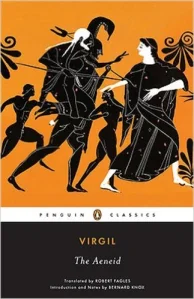Welcome to the readalong of Virgil’s Aeneid. I will post about this gorgeous epic poem once a week, and do hope that you will comment and share your own reactions. There is no single interpretation, and every reading or rereading is different. Whether you read a translation or the Latin, you will travel to the same place. All the translations are excellent. From time to time I will say a few words about the Latin.
This week we are discussing Book I. The schedule is at the bottom of this post.
Today I wrote briefly about Aeneas as a modern hero, and the paintings at Juno’s temple.
AENEAS AS A MODERN HERO
 If you have to be a hero, why complain about it?
If you have to be a hero, why complain about it?
That is how I responded to Virgil’s Aeneid the first time I read it as a very young woman.
Virgil’s complex characterization of Aeneas as a depressed, reluctant, tragic leader was innovative in epic. Based on Homer’s Iliad and Odyssey, poems inspired by the Trojan War, the Aeneid has a different Roman slant on the heroic life. Aeneas is a stretched to his limits by war and exile. He does not have the perfect confidence of Homer’s heroes, nor the luxury to sulk in his tent, as Achilles did in the Iliad. Fated to ensure the survival of the Trojan people, Aeneas must sacrifice his personal life to lead the refugees of the Trojan War to Italy, where they will found Rome. Virgil describes him as fessus (tired). And Aeneas can’t give the job to someone else.
You must understand the Roman concept of pietas to appreciate the Aeneid. Pietas is not quite the same as piousness: it means duty to the gods, one’s country, and one’s family. Aeneas is repeatedly called pius Aeneas: such epithets are characteristic of epic, but this one reminds us of why Aeneas does what he must do.
As Virgil explores the conflict between the longings of the personal man and the stoicism of the public figure, he creates a new kind of poem. Our culture has no comparable concept to pietas, and we have no epic like the Aeneid.
We first meet Aeneas in a shipwreck, when he is very much the personal man, wishing himself dead. He says (and I have given both the Latin and the English):
The Latin:
…’O terque quaterque beati,
quis ante ora patrum Troiae sub moenibus altis
contigit oppetere!
A literal English translation:
“O three and four times blessed, those who happened to meet death before the altars of their fathers under the high walls of Troy!”
Aeneas is tired. The Trojans are tired. The ships are described as tired.
But when Aeneas and only seven of his 20 ships reach the shores of Libya, he must be strong and says (Fagles’s translation): “My comrades, hardly strangers to pain before now, we have all weathered worse.”
And he delivers one of the most famous lines in the poem:
forsan et haec olim meminisse iuvabit.
“Perhaps one day it will be a joy even to remember these things.”
He has lost his wife, friends, and many relatives in the war. Does he believe what he says? He knows how to say it.
And doesn’t this remind us all of sadness and disasters we have overcome?
And now on to
ECPHRASIS: THE PICTURES AT THE TEMPLE
One of the most fascinating features of epic is ecphrasis, a term used to describe the meaning of works of art. When Aeneas stumbles upon a temple to Juno (a goddess who hates him, by the way), he has strong reactions to the paintings on the walls. The paintings depict episodes in the Trojan War. Even he is depicted in one of them, in combat with the Greeks. And so he believes Queen Dido, who is building the city of Carthage, will be friendly to him and his followers.
But what do the pictures really mean? Virgil tells us that Aeneas” feeds his spirit” and cries over pictura inani, which means an “empty picture,” an “idle picture,” or a “worthless picture.”
But Aeneas is so moved by the lasting fame of the Trojan heroes in art that he says the following (another famous line):
Here is the Latin:
sunt lacrimae rerum et mentem mortalia tangunt.
Literally it means, “These are the tears of things and human woes touch the mind.”
The poet Robert Fagles translates it:
even here, the world is a world of tears and
the burdens of mortality touch the heart.
And Robert Fitgerald translates it: “…they weep here
for how the world goes, and our life that passes
Touches their hearts.”
Many critics question Aeneas’s interpretation that the paintings show sympathy for the Trojans. Both Greeks and Trojans are portrayed: often the Trojans are routed by the Greeks. And the frieze is at the temple of Juno, who favors the Greeks,.
I do not have a firm grasp on this: in other words, sometimes it means one thing to me, sometimes another. Dido and Aeneas become friends, which supports Aeneas’s theory, but Juno and Venus (Aeneas’ mother) did some ground work to make this happen.
It’s complicated!
Let me know what interests you about Book I. There is so much here.
THE SCHEDULE FOR JANUARY.
Jan. 8-14: Book I
Jan. 15-21: Books II and III (the “short version” is Book II)
Jan. 22-28: Book IV
Jan. 29-Feb. 4: Books V and VI (the “short version” is Book VI)
The schedule for February, including the “short version,” will be announced later.


